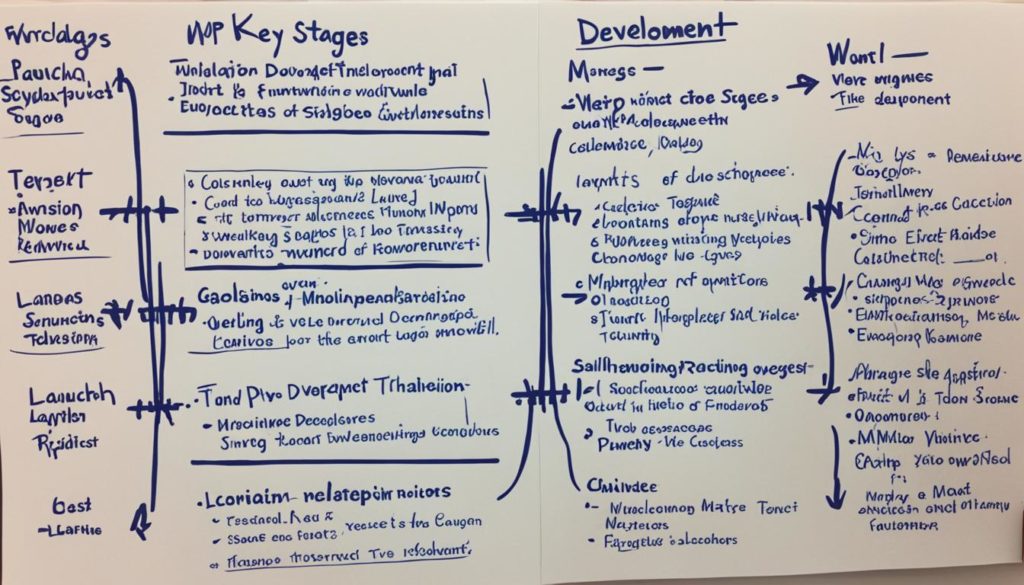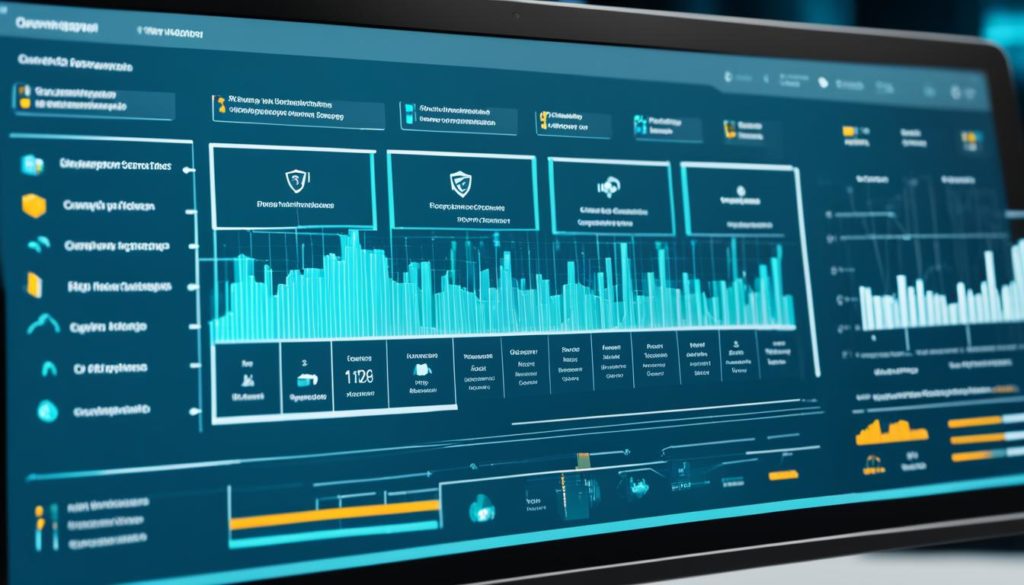
Did you know, the “Open Source Security Risk and Analysis” (OSSRA) report found that 96% of codebases have open source parts? This highlights the need for a Software Bill of Materials (SBOM). Since our software often includes open source components, tracking them with an SBOM is vital.
A Software Bill of Materials (SBOM) lists all the open source and third-party parts in a codebase. It’s similar to a BOM in manufacturing, detailing every part. This provides key details like component names, versions, and where they came from. It helps spot security and license concerns too.
Think of an SBOM as a spotlight on the inner workings of our code. It boosts understanding and helps with cybersecurity compliance. SBOMs let us quickly find and tackle security holes. They even played a role in avoiding another Equifax-like breach in 2017.
There’s a growing push for SBOMs in the face of changing cybersecurity challenges. Executive Order 14028 now requires an SBOM for software sold to the U.S. government. The Cybersecurity and Infrastructure Security Agency (CISA) also needs secure software development forms.
Key Takeaways
- 96% of scanned codebases contain open source components, underscoring the need for SBOMs.
- An SBOM provides detailed information about each software component, promoting transparency.
- SBOMs are crucial for identifying and managing security and license risks.
- Federal regulations, like Executive Order 14028, mandate the generation of SBOMs for software provided to the U.S. government.
- Incorporating SBOMs can prevent significant cybersecurity incidents, exemplified by the Equifax data breach.
Why Do Organizations Need a Software Bill of Materials?
Organizations see a need for a Software Bill of Materials (SBOM) due to recent security issues. These problems push for better cybersecurity and more oversight over software. By knowing what’s inside the software, companies can spot and fix security dangers quickly. They can also make sure they follow the rules correctly. Big cyberattacks have made presidents and leaders stress the need for SBOMs to keep their software secure.
Ensuring Security Compliance
Keeping an eye on open source parts is key for following cybersecurity rules. SBOMs list all parts of a software, helping teams quickly fix any weak spots. This aligns with government rules and boosts software safety. It also creates a clear report that shows companies are serious about security.
CISA Guidelines and Federal Regulations
The Cybersecurity Infrastructure Agency (CISA) has rules that ask for clear software safety proof. These rules help keep both private and government software safe. SBOMs check that software meets these high security standards. They’re also becoming an important part of making sure software is safe from cyber threats.
What’s in a Software Bill of Materials?
A Software Bill of Materials (SBOM) lists everything in a software’s codebase. It makes software analysis clear and ensures open source components are managed well. This helps identify and fix vulnerabilities, and ensures licenses are followed.
Open Source Components
Open source components are key in today’s software creation. An SBOM keeps track of these parts, showing where they came from and their version details. This helps developers handle issues with old or incompatible parts early.
Licenses and Versions
Components in a codebase have their own usage rules, set by their licenses. An SBOM makes sure these rules are known, helping organizations follow the law. Tracking versions also keeps software up to date and secure, lowering risks and keeping the software safe.
Vulnerability Information
Knowing component vulnerability info is key to protect software. An SBOM records these weaknesses, helping find and fix risks early. This keeps cyber defenses strong.
Looking at reports like “Open Source Security Risk and Analysis” (OSSRA) shows how often open source parts are used. It highlights why good documentation with SBOMs is crucial for meeting legal and safety needs.
How to Create a Software Bill of Materials
Creating an SBoM needs a careful process. We make sure to list all software parts, even those made by others or unique to us. Using advanced software composition analysis tools, such as Black Duck®, helps a lot. These tools stay updated on open source risks, giving us the latest info.
It’s important to use software composition analysis tools in our work. They help all software developers keep track of the many parts that make up today’s software. These tools make the job easier by automatically checking the security and legality of a software’s parts.
Now, let’s see how SCA tools simplify things:
- Detection: Finds all pieces, even the open-source parts.
- Documentation: Creates a detailed SBoM. It notes the license, version, and where each part comes from.
- Compliance: Makes sure we follow the rules and standards.
- Security: Updates the SBoM regularly with new security flaw details.
Here’s a detailed look at top software composition analysis tools:
| Tool | Strengths | Features |
|---|---|---|
| Black Duck® | Comprehensive analysis | Detects vulnerabilities, manages licenses, gets continuous updates |
| WhiteSource® | Easy to use interface | Offers real-time alerts, helps manage license risks, enforces policies automatically |
| Snyk® | Adaptable integration | Provides real-time checks, integrates well with different development processes, has a thorough vulnerability database |
This shows that using powerful SCA tools lets us really understand our software’s makeup. This means we can be active in making our software secure and following the rules.
Benefits of Using a Software Bill of Materials
The Software Bill of Materials (SBOM) brings many benefits. It makes things clear, improves security, and makes it easier to manage risks. When you know what’s in your software, you can make better decisions. You can find and fix problems faster. And you can do exact audits.
Enhanced Software Transparency
Being clear about what’s in software builds trust. SBOMs tell users and providers exactly what’s in the product. This helps check if everything follows important rules, like GDPR. It makes users more confident and helps follow government rules, such as Biden’s order in May 2021.
Vulnerability Management
SBOMs are great for handling software risks. They let organizations find and fix bugs more accurately. For example, in the XZ Utils backdoor case, an SBOM helped find and fix a big risk quickly. This makes dealing with threats much faster, lowering possible harm.
To see how SBOMs help with bug fixing, go here.
Risk Mitigation
SBOMs are excellent at reducing risks. They share clear details about software parts. This helps find and fix risks linked to old or bad software. A careful approach decreases problems and keeps the software safe. It also helps with following rules and lowers risks, specifically in new cloud tech.
To really understand how SBOMs lower risks, read this guide.
Tools for Generating Software Bill of Materials
Choosing the right tools for software composition analysis is key. It ensures the SBOM, or Software Bill of Materials, is accurate. The best tool makes the whole SBOM process work well. We’ve looked into CycloneDX, Syft by Anchore, Fossa, and MergeBase. They all have their own special features that help make SBOMs better.
Software Composition Analysis Tools
Tools like Black Duck® and GitLab are important for detailed SBOMs. They keep track of software vulnerabilities. They also work with other tools to manage those risks well. CycloneDX, Syft, Fossa, and MergeBase do different jobs but are all useful:
- CycloneDX: It makes SBOMs without needing source code. It’s accurate and not too hard to use, thanks to its Gradle or Maven plugins.
- Syft: An open-source tool making SBOMs from Docker images. It’s easy to use even though some entries may not apply.
- Fossa: Fossa makes SBOMs in text format, which might be harder for machines to read. It’s fairly easy to use, but the license information could be clearer.
- MergeBase: It’s very easy to use and makes precise SBOMs. It fits well into building processes and doesn’t need source code.
Choosing the Right Tool for Your Needs
Picking the right SCA tool means knowing what your organization needs. For example, some tools might not need the actual source code. Yet, they could be quite easy to use and give accurate results.
| Tool | Source Code Requirement | Ease of Deployment | Accuracy | Notable Features |
|---|---|---|---|---|
| CycloneDX | None | Moderate | High | Generates XML & JSON formats, Gradle/Maven plugins |
| Syft | None | High | Moderate | Generates from Docker images, open-source |
| Fossa | None | Moderate | High | Plain-text SPDX format |
| MergeBase | None | Very High | High | Build process integration |
The right tool depends on what your organization values, like following rules, growing easily, or fitting in with others. For example, if you work in DevOps, tools like Syft by Anchore might be top choices. They’re great at working with Docker. On the other hand, tools like CycloneDX provide detailed information in specific formats. This can be great for those who need it. CycloneDX and MergeBase are good for making your work flow smoothly with your other tools, like CI/CD, for continuous development. Tools like Black Duck® and Fossa really help us do a good job handling software risks. This is by keeping our SBOMs up-to-date with what’s really happening.
Conclusion
The Software Bill of Materials (SBOM) is vital in today’s software world. It helps make applications more secure and compliant with rules. With SBOM, organizations can deal with issues in open source and third-party parts. This is key for the software to work well on all devices and systems.
SBOM tools and methods are key in complex software areas. They help us manage what software is used, its version, and any weak points. This way, we see our software clearly, leading to stronger security.
In the future, SBOMs will be even more important in all software, public or private. They encourage us to be careful and responsible, which is crucial for software safety. Using SBOM prepares us for the future’s software needs, ensuring our software is always reliable.
FAQ
What is a Software Bill of Materials (SBOM)?
An SBOM is a detailed list of all software components in a codebase, both open source and third-party. It lists the licenses, versions, and patch status. This helps find security and legal risks lurking in the software.
Why do organizations need an SBOM?
Having an SBOM is key to meeting security standards, handling open source risks, and securing software distributions. It ensures compliance with rules from groups like CISA and President Biden’s recent cybersecurity order.
What are the components of an SBOM?
It contains open source pieces, their licenses, versions, and any known threats. This info is vital for meeting licensing rules, avoiding risks from outdated parts, and quashing security dangers from unpatched software.
How do you create an SBOM?
Use SCA tools to make an SBOM. These tools scan all software items, from third-party to unique parts. They keep the inventory constantly updated to manage open source risks.
What are the benefits of using an SBOM?
SBOMs boost software clarity and help manage weaknesses better. They improve how organizations deal with risks, letting them make smart security choices. SBOMs also ease vulnerability tracking and ensure precise audits, making software more secure.
What tools can generate an SBOM?
Essential tools for SBOMs are Black Duck and GitLab. They track vulnerabilities continuously, mesh well with other vulnerability tools, and pull SBOM data from multiple sources easily.
How do you choose the right SCA tool for your needs?
To pick the best SCA tool, consider how it meets your needs. Look for tools that monitor vulnerabilities, follow standards such as OWASP CycloneDX and SPDX, and easily swap SBOM data.
Future App Studios is an award-winning software development & outsourcing company. Our team of experts is ready to craft the solution your company needs.









